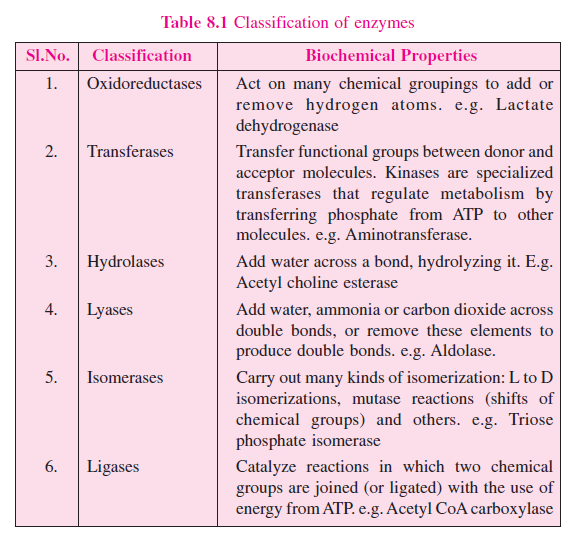Classification Of Enzymes
Since earlier days to still date, fanciful names such as pepsin, chymotrypsin, etc were used to name enzymes. Later the suffix “ase” to the substrate was used to name enzymes. For example the enzymes lactase acts upon the lactate and produces glucose and galactose. The above method is known as “trivial naming” of enzymes. Currently enzymes are grouped into six functional classes by the International Union of Biochemists and Molecular Biology (IUBMB). As per the IUBMB system, each enzyme name starts with EC (enzyme class) followed by 4 digits. The first digit represents the class, the second digit strands for the subclass, the third digit represents the sub-subclass or subgroup and the fourth digit provides the particular enzyme (Table 8.1)

These rules give each enzyme a unique number and specifies a textual name for each enzyme. Enzymes are also classified on the basis of their composition. Enzymes composed wholly of protein are known as simple enzymes in contrast to complex enzymes, which are composed of protein plus a relatively small organic molecule. Complex enzymes are also known as holo-enzymes. The nonprotein component of an enzyme may be as simple as a metal ion or as complex as a small non-protein organic molecule. Enzymes that require a metal in their composition are known as metalloenzymes. Metalloenzymes bind and retain their metal atom(s) under all conditions with very high affinity. Enzymes with lower affinity for metal ion, but still require the metal ion for activity, are known as metal-activated enzymes. Based on requirement of ATP, enzymes are further classified into two types namely synthetases and synthase. Synthetases are ATPdependent enzymes catalyzing biosynthetic reactions. Synthetases are enzyme belong to the class 6 (Ligases). Enzymes such as Carbamoyl phosphate synthetase, Arginino succinate synthetase and Glutamine synthetase are examples of the synthetases group of enzymes. The enzyme class other than ligases includes synthases. Synthases group of enzymes involves in catalyzing biosynthetic reactions that do not require ATP directly. Enzymes such as glycogen synthase and Alanine synthase are examples of synthase group.
Intex Question
1. There are …………….. main groups of enzymes.
2. Lactate dehydrogenase is example for …………….. group of enzyme.
3. Enzymes that require a metal in their composition are known as ……………..
4. …………….. are ATP dependent enzymes.
5. …………….. and …………….. are examples for synthase group of enzymes.
